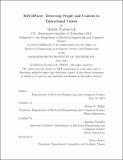| dc.contributor.advisor | Robert C. Miller and Antonio Torralba. | en_US |
| dc.contributor.author | Pratusevich, Michele | en_US |
| dc.contributor.other | Massachusetts Institute of Technology. Department of Electrical Engineering and Computer Science. | en_US |
| dc.date.accessioned | 2016-01-04T20:01:57Z | |
| dc.date.available | 2016-01-04T20:01:57Z | |
| dc.date.copyright | 2015 | en_US |
| dc.date.issued | 2015 | en_US |
| dc.identifier.uri | http://hdl.handle.net/1721.1/100647 | |
| dc.description | Thesis: M. Eng. in Computer Science and Engineering, Massachusetts Institute of Technology, Department of Electrical Engineering and Computer Science, 2015. | en_US |
| dc.description | This electronic version was submitted by the student author. The certified thesis is available in the Institute Archives and Special Collections. | en_US |
| dc.description | Cataloged from student-submitted PDF version of thesis. | en_US |
| dc.description | Includes bibliographical references (pages 61-65). | en_US |
| dc.description.abstract | There are thousands of hours of educational content on the Internet, with services like edX, Coursera, Berkeley WebCasts, and others offering hundreds of courses to hundreds of thousands of learners. Consequently, researchers are interested in the effectiveness of video learning. While educational videos vary, they share two common attributes: people and textual content. People are presenting content to learners in the form of text, graphs, charts, tables, and diagrams. With an annotation of people and textual content in an educational video, researchers can study the relationship between video learning and retention. This thesis presents EdVidParse, an automatic tool that takes an educational video and annotates it with bounding boxes around the people and textual content. EdVidParse uses internal features from deep convolutional neural networks to estimate the bounding boxes, achieving a 0.43 AP score on a test set. Three applications of EdVidParse, including identifying the video type, identifying people and textual content for interface design, and removing a person from a picture-in-picture video are presented. EdVidParse provides an easy interface for identifying people and textual content inside educational videos for use in video annotation, interface design, and video reconfiguration. | en_US |
| dc.description.statementofresponsibility | by Michele Pratusevich. | en_US |
| dc.format.extent | 65 pages | en_US |
| dc.language.iso | eng | en_US |
| dc.publisher | Massachusetts Institute of Technology | en_US |
| dc.rights | M.I.T. theses are protected by copyright. They may be viewed from this source for any purpose, but reproduction or distribution in any format is prohibited without written permission. See provided URL for inquiries about permission. | en_US |
| dc.rights.uri | http://dspace.mit.edu/handle/1721.1/7582 | en_US |
| dc.subject | Electrical Engineering and Computer Science. | en_US |
| dc.title | EdVidParse : detecting people and content in educational videos | en_US |
| dc.title.alternative | Detecting people and content in educational videos | en_US |
| dc.type | Thesis | en_US |
| dc.description.degree | M. Eng. in Computer Science and Engineering | en_US |
| dc.contributor.department | Massachusetts Institute of Technology. Department of Electrical Engineering and Computer Science | |
| dc.identifier.oclc | 933247843 | en_US |
